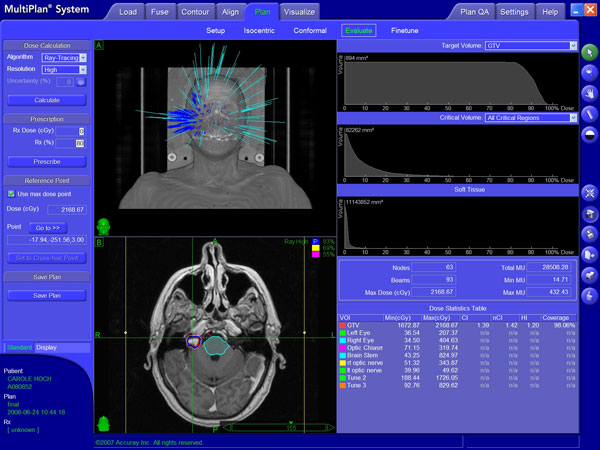CyberKnife Radiosurgery for Acoustic Neuromas and Skull Base Tumors

The cyberknife treatment suite features a comfortable , warm environment with a computer controlled table and aiming system. The treatment beams are delivered from many directions by a robot that moves to precise positions determined by each patients’ individualized treatment plan.
It has long been known that the growth of malignant and benign tumors can be controlled with high energy x-ray beams. Traditionally, the entire area containing the tumor was exposed to these x-ray beams resulting in side effect from exposure of normal tissues to high doses of x-rays. To minimize these consequences, traditional radiation therapy treatments are given over a period of 5-7 weeks. Radiosurgery began in the 1960’s in Sweden. Hundreds of radiation beams were aimed to converge from different angles to a single spot on the tumor. In this way, only the tumor receives an extremely high dose of radiation and a minimum of surrounding tissue was exposed to these high doses. It was realized that the better these converging beams could be aimed at the target, the higher was the dose that could be delivered and even lower doses would be delivered to the surrounding tissues. This beneficial differential in dosing between the tumor and the surrounding tissues remained true even in single treatment techniques but could be enhanced when 2, 3 or more treatments were given. Early systems to deliver radiation in this way include the Gamma Knife and the X-Knife systems. These could be used only for tumors in the skull and upper neck. Recently, the CyberKnife, robotic radiosurgery system, has increased the accuracy and beneficial dose differential for treatment of skull base tumors. It does this by using extremely accurate targeting using a robotic arm like those used in automobile manufacturing to hold the x-ray beam. This robotic arm can be programmed to identify the exact location and dimension of the tumor and aim up to 1200 different beams from different directions that overlap only in the tumor. This results in unparalleled accuracy and allows even higher doses of radiation to the tumor which increases cure rates. These high doses are not given at the expense of damage to the surrounding tissues. These surrounding tissues receive the same or even less radiation. This is a critical feature because the tissues surrounding an acoustic neuroma or a skull base tumor include critical structures such as the brain stem, facial nerve, optic nerves and inner ear.
Other advantages have distinguished this form of radiodurgery compared to other techniques. Because the number of treatment beams is larger and are straight “pencil beams” rather than spheres the CyberKnife can create an effective dose plan that delivers an effective dose throughout the tumor even when the tumor has a complex shape. Another advantage of CyberKnife robotic radiosurgery is that there is no need for a head frame as with other systems. It is also more accurate and can treat tumors anywhere in the body. When you schedule your CyberKnife treatment you will be asked to return for a high resolution MRI scan which will be used for planning your treatment and entering data about your tumor into the computer used to deliver the treatment. Treatment planning will be coordinated between your surgeon and the radiation oncologist and when a treatment plan has been created, (usually in 1 to 2 weeks), you will return for your first treatment. You will typically not feel anything after your treatment and can return to work right away. You will return for 3 to 5 treatments depending upon your treatment plan. In some cases, all of the treatment will be done at a single session. There is no anesthesia used during the CyberKnife treatment. Other questions about the CyberKnife treatment can be answered by your treating surgeon and radiation oncologist.

Here is the treatment plan for a patient with a small acoustic neuroma. The blue lines(beams) passing through the head all converge on the tumor so the high dose area is very small and centered on the tumor. In this case 95 beams are used which avoid the eyeballs, optic nerved and other critical structures included in the plan. The tumor has multiple color outlines and the dose at the outermost pink outline that is just over the surface of the tumor is 55% of the tumor treatment dose. The brainstem is a critical structure and is outlined in light blue. It’s closest area receives only 20% of the treatment dose in this plan.

The Cyberknife treatment area is located in the Helen Graham Cancer Center at Christiana Care

Information Provided by Dr. Michael Teixido, MD
Dr. Teixido is a board certified Otolaryngologist and Otologist/Neurotologist, with a special interest in medical and surgical conditions that affect hearing and balance. He is actively pursuing his goals of advancing the study and understanding of problems involving hearing and balance as a result of hereditary hearing conditions in his own family. View Dr. Teixido's Full Bio
FOULKSTONE
PLAZA
1401 Foulk Road.,
Suite 205
Wilmington, DE 19803
Phone: (302) 998-0300
Fax: (302) 478-8069
Greenville
Location
1011 Centre Rd,
Suite 200,
Wilmington DE 19805
Phone: (302) 998-0300
Fax: (302) 543-8456
MIDDLETOWN
CROSSING
306 EastMain Street
Middletown, DE 19709
Phone: (302) 998-0300
Fax: (302) 376-5251
NEWARK- IRON HILL
CORPORATE CENTER
700 Prides Crossing
Suite 200
Newark, DE 19713
Phone: (302) 998-0300
Fax: (302) 998-5111

